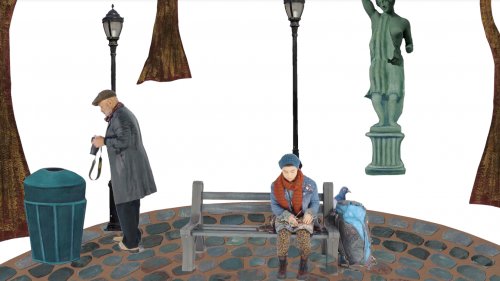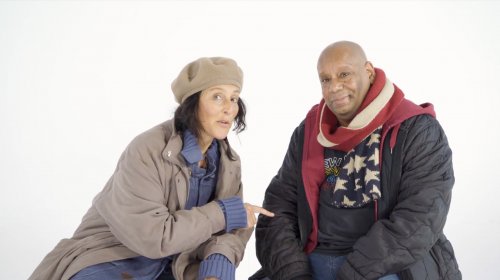Addressless: A Walk in Our Shoes
Can three actors portray the desperation of New York City’s homeless population?

Hope Beaver as Social Worker and Joey Auzenne as Louis in a scene from Jonathan Payne’s “Addressless: A Walk in Our Shoes”
[avatar user=”Joel Benjamin” size=”96″ align=”left”] Joel Benjamin, Critic[/avatar]
Turning the plight of New York City’s homeless into a game is an iffy proposition to say the least. At best, the audience for the theatrical effort, Addressless: A Walk in Our Shoes, learns about the daily terrors facing this disenfranchised population; at worst, the interactive game overshadows the very same awful truths turning homelessness into a superficial search for more and more points.
The Zoom audience, giving advice to the actors who portray the unfortunate avatars of three luckless souls, takes the focus off of their tragic, often inescapable circumstances.
This Rattlestick Playwrights Theater production of Addressless approaches these fragile logistics head on with only partial success. Directed and created by Martin Boross and written by Jonathan Payne, the show focuses on three people: teen runaway Josie (a touchingly fragile Bianca Norwood) with two drug addicted parents; an army vet, Louis (a tough but vulnerable Joey Auzenne), unprepared for civilian life; and recovering alcoholic Wallace (Shams DaBaron aka “The Homeless Hero,” boisterous and energetic), the father of a teenage son. The host is the Social Worker from the Henry Street Settlement, played with professional coolness and kindness by Hope Beaver who takes on the role of game master.
The Zoom audience is divided into three teams: Team Josie, Team Louis and Team Wallace. It’s each team’s responsibility to help its namesake navigate the precarious and often bizarrely bureaucratic challenges that define the homeless problem in New York City.
The goal of the game is for each of the three to accumulate an account of $1,500 so that they will be eligible for housing. The path to this goal is paved with a complicated combination of gains and losses that are determined by each of the three with the (sometimes terrible) advice of their teams. A chart supervised by Hope follows their progress.

Bianca Norwood as Josie in a scene from Jonathan Payne’s “Addressless: A Walk in Our Shoes”
Louis chooses to go to a drop-in shelter aimed at vets but finds he has to fend off threats from the other shelter tenants, including being beaten up. Should he move to another shelter?
As Josie sits on a park bench she is approached by an older man who claims to be a famous photographer. After wooing her with compliments and money he invites her up to his nearby studio for more “in depth” modeling. Should she go, tempted by the possibility of enough cash to survive on the streets for a few more days knowing full well that this older man is preying on her?
Wallace’s story is a bit more complicated. He manages to get himself hired as a home health care aide to take care of an elderly man. However, the patient’s daughter finds out that Wallace is homeless. She blames him for a rash that has come out on her father’s back claiming that Wallace brought bedbugs to the apartment. She offers Wallace one hundred dollars, but he wants the salary due him.
The Zoom teams put their two cents in as each of the homeless request advice about how to proceed.
Addressless follows these three and the important decisions they make over the course of several months. Hope keeps track of their ups and downs on the chart she exhibits for the Zoom audience’s consideration.
The show gets into the nitty-gritty of the challenges facing Josie, Louis and Wallace. For instance, Josie runs into an old school friend and will not permit the friend to help her. She fears pity. Louis misses his Food Stamp interview and faces hunger. Wallace falls in love with a woman he met at a soup kitchen. Do they have a future? And, what about Melvin, his teen son? Will she love him?

Lisa Ramirez and Shams DaBaron a.k.a. “The Homeless Hero” as Wallace in a scene from Jonathan Payne’s “Addressless: A Walk in Our Shoes”
The time set aside for the audience input stops the flow of each character’s moving story, however satisfying it may be to influence another person’s life with good intentions. The phony setup of Addressless takes away from the suffering and confusion of the characters portrayed by the three actors—helped by the occasional addition of minor characters played by Faith Catlin, Chima Chikazunga, Paten Hughes, Mahira Kakkar, Tara Khozein, Michael Laurence, Olivia Oguma, Lisa Ramirez, Keith Randolph Smith, and Alok Tewari.
Even more pertinent is the question: Can three actors adequately portray the desperation of the homeless population, even if one of them had been homeless, himself? The artificialness of the direction and production are hard to overcome. In the end, do we really feel for Josie, Louis and Wallace?
The cartoon graphics don’t help even partnered by realistic props (Patricia Marjorie), costumes (Olivera Gajic), sound design (Julian Evans) and music (Tara Khozein). The overall production design is credited to Johnny Moreno with technical design by William Fastenow and graphics by Maiko Kikuchi.
Even an ending that is heartwarming is presented as an exchange of earned credits.
If interactive theater is appealing then Addressless might be a satisfying experience. If not, great patience is needed to get to the gist of the issues faced by our homeless population as presented by Addressless.
Addressless: A Walk in Our Shoes (streaming January 20 – February 13, 2022)
Note: Performances are available only via Zoom
Rattlestick Playwrights Theater, 224 Waverly Place, in Manhattan
For tickets, call 551-223-1304 or visit http://www.rattlestick.org
Running time: two hours without an intermission






Leave a comment